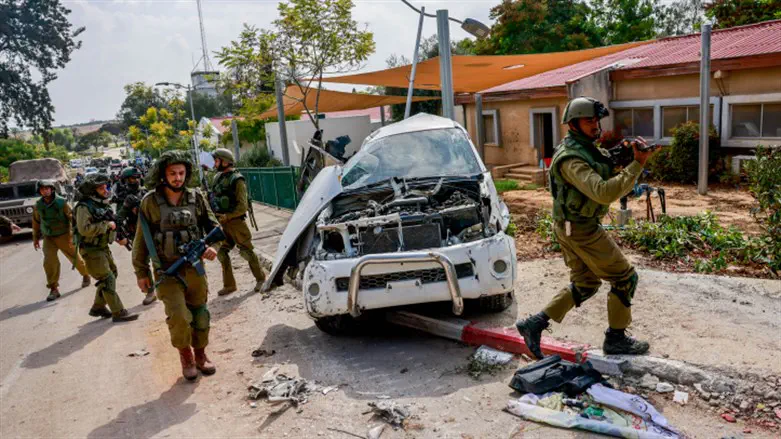
The investigation into the events at Kibbutz Kfar Aza on October 7, 2023, which was presented to the bereaved families, the kibbutz community, and members of the local security squad, found that the IDF failed in its mission to defend the kibbutz during the terrorist attack on October 7.
Despite the military failure, the findings of the investigation emphasized the courage and resourcefulness of the members of the local security squad and residents, who demonstrated heroism in the battle against the terrorists.
According to the findings, approximately 250 terrorists from Hamas' Gaza City Brigade infiltrated the kibbutz, well-armed and equipped with explosives, and began a campaign of murder, looting, and kidnapping. According to estimates, about one hundred terrorists were eliminated inside the kibbutz and fifty more outside its borders. The kibbutz suffered heavy damage and the process of rebuilding it is expected to take a significant amount of time.
The surprise attack began at 06:29 in the morning with heavy fire at the posts in the area, and within a few minutes, the terrorists penetrated through gaps in the security fence. Some even glided into the kibbutz using paragliders.
The investigation shows that the first IDF forces arrived in the area only after more than two hours had passed since the attack began, and for a long time, the local residents fought the terrorists alone. The members of the local security squad, who went out to fight dozens of armed terrorists, suffered heavy losses – seven of them fell in battle.
A total of 62 residents of the kibbutz were murdered, while 19 were kidnapped into Gaza. Two of the kidnapped were accidentally killed by fire from Israeli forces during the fighting in Gaza, and two more are still being held captive by Hamas.
Phases of the battle:
- Phase 1 (06:29-08:30): The terrorists infiltrated and launched the attack. The terrorists breached the security fence and entered the kibbutz at several locations, carrying out mass killings.
- Phase 2 (08:30-12:00): A campaign of murder and kidnappings. At 09:50, the first small military force entered the kibbutz, but the situation remained chaotic, and the terrorists continued to execute residents and kidnap them into the Gaza Strip.
- Phase 3 (12:00-18:30): Attempts to contain the situation and the arrival of additional military forces. The command was not in control of the situation, which made it difficult to coordinate the fighting.
- Phase 4 (18:30-08:00 the next day): Continued fighting, the terrorists entrenched themselves, and the rescue efforts began.
- Phase 5 and beyond: Clearing the kibbutz and working to return the hostages.
The main conclusions of the investigation:
The IDF failed to defend the kibbutz – military forces did not arrive in time, and the local security squad was forced to deal with dozens of terrorists alone.
Deficiencies in readiness and defense conceptions – military preparedness was lacking, and there were no clear plans in case of such a large-scale attack.
Poor control of the fighting – military forces arrived in the area without appropriate equipment, without organized intelligence, and without coordination, which led to chaos on the battlefield.
The evacuation of residents was disorganized – most of the evacuations were carried out on local initiatives and without sufficient security.
The Air Force had almost no impact on the fighting in the kibbutz – despite several airstrikes, the terrorist attacks continued without significant disruption.
The investigation was conducted by the 55th Reserve Paratroopers Brigade, under the command of Lieutenant Colonel Oded Ziman, and included interviews with kibbutz residents, members of the security squad, and the security forces who operated in the area. Testimonies, video documentation, and communication recordings were also collected that shed light on the events of that day.
